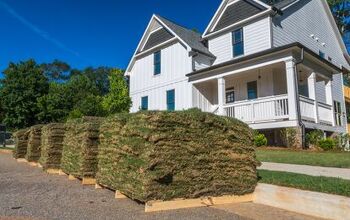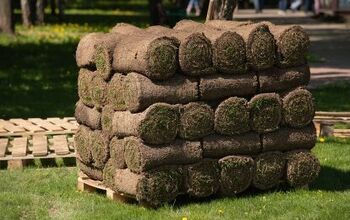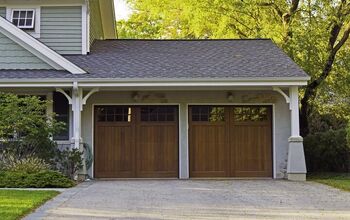How Many Square Feet In A Yard Of Concrete? (Find Out Now!)

You’re about to pour a new slab, and that’s exciting. But it’s also stressful when you don’t know how many square feet of concrete are in a yard. And understanding this information is essential. How else will you tell whether a contractor is giving you a fair price or not?
Here’s what you need to know: One cubic yard of concrete will most likely cover about 81 square feet. However, the type of concrete you use may increase or decrease its spreadability. So, read the bag and measure your workspace carefully.
Do You Need Concrete, Brick, or Stone Pros?
Get free, zero-commitment quotes from pro contractors near you.

What Is a Yard of Concrete?
Many homeowners want to know how they can measure a yard of concrete. Firstly, most contractors use cubic yards to measure concrete yardage. So, they standardize their units to ensure uniformity across the board. And that way, the same yard of concrete covers the same ground no matter where you install it.
Meanwhile, there are 27 cubic feet in every cubic yard of concrete. That means a single cubic concrete unit will create a slab that’s three feet high, three feet wide, and three feet deep. For details and to find out how a cubic foot will transform your property, talk to a cement mason.
TIP: Ask your contractor for a detailed description of their calculations and look for an itemized list of finishing supplies.
How Many Bags of Concrete Make a Cubic Yard?
You’ll need at least 45 bags of concrete if you’re trying to pour one cubic yard. Remember, a cubic yard is 3 feet by 3 feet by 3 feet. So, expect to buy some extra supplies if you want a thicker slab. And try not to mix this much material by hand because it can be cumbersome manually.
DID YOU KNOW: You can buy or rent small concrete mixers to use at home if you want to DIY a slab to save money.
How Many Bags of Concrete for a 4-Inch Thick 10×10 Slab?
Many concrete slabs are about four inches thick. And that’s the average thickness for private driveways and city sidewalks too. So, how many bags of concrete do you need to cover a 10×10 slab if you maintain the average consistency? The answer is about 49 bags.
Forty-nine bags of 90lb ready mix concrete will most likely cover a 10×10 space. However, you’ll need 56 bags if you choose 80lb concrete instead. And you might need additional bags as your poundage goes down. For example:
- The same job will require 74 bags if you use 60lb concrete.
- You’ll need 111 bags of 40lb ready mix if that’s what you choose.
- The lower quality of the concrete, the more bags are required to finish the job.
A 10×10 slab is relatively tiny compared to others. So, don’t be afraid to fudge the numbers and poundage to find the perfect cost-to-quality ratio. Also, be sure to measure your concrete bag requirements carefully, so you don’t run out of supplies.
TIP: If pouring concrete gets too time-consuming or expensive, consider laying paver stones instead.
How Thick Should a Concrete Slab Be?
The average concrete slab is approximately four inches thick, give or take a few centimeters. However, new standards say that four inches aren’t quite thick enough. And that’s especially true for busy sidewalks, driveways, or patios.
In those cases, master masons recommend at least a five to six-inch thickness. That’s because thicker slabs can handle heavier loads for longer. Thus, paying more for thicker slabs may help save you money in the long run.
Determine the ideal thickness of your new concrete slab by cutting the ground level. Then, pour the concrete to the proper depth before letting it dry. Then check for spots you can refinish or repour.
Tips for Measuring a Bag of Concrete
Measuring a bag of concrete is easier than you think. It involves a simple formula that starts with finding the area in feet. Here’s how to do that:
Area = Length (L) x Width (W)
If your slab is 10×10, that will make the area 100 square feet. Now, do the same thing again, but add the thickness into your equation this time. The formula should look like this:
Length (L) x Width (W) x Thickness (T)
Next, divide that number by 27 to calculate the total cubic yards of each bag. Also, be sure to account for the kind of concrete you purchased. And remember, lower poundage may cost less upfront, but it might not cover as much area or achieve the thickness you need.
TIP: Buy one or two extra bags of concrete for every cubic yard you pour to prevent unexpected supply shortages.
Measure Twice, Pour Once
Calculating the required cubic yards of concrete for your slab can be difficult if you don’t know the formula. So, speak to your contractor for more information. Or measure at least twice before pouring anything even once. Here’s a concrete calculator for your convenience.
Do You Need Concrete, Brick, or Stone Pros?
Get free, zero-commitment quotes from pro contractors near you.

Related Questions
How Much Do Two Yards of Concrete Cost?
As of 2020, the average price for a cubic yard of concrete was about $124. So, two yards of concrete will cost around $248, depending on the type. Application methods, thickness, and timing may factor into the price as well.
How Many Wheelbarrows Are In a Cubic Yard?
Wheelbarrows vary widely in size, but most of them have a 2-3 cubic foot capacity. So, you can transport a cubic yard of concrete after 9 to 14 full loads in the average wheelbarrow. Just be careful not to tip it because the concrete will start to dry where it lands.
Is It Cheaper to Pour Your Own Concrete?
If you have the skills, it may be less expensive to pour your own concrete slab. However, the cost of renting equipment and the time spent curing it may mean it’s wiser to let a professional do the work. Talk to an expert to go over the pros and cons.
Related Guides

Tiffany Nichols specializes in aesthetics, design, marketing, and manufacturing. She's a copywriter and editor for several home renovation companies in the U.S. and works alongside some of the biggest names in the industry. Her hobbies include architecture, art, mental health, and fashion.
More by Tiffany Nichols



























